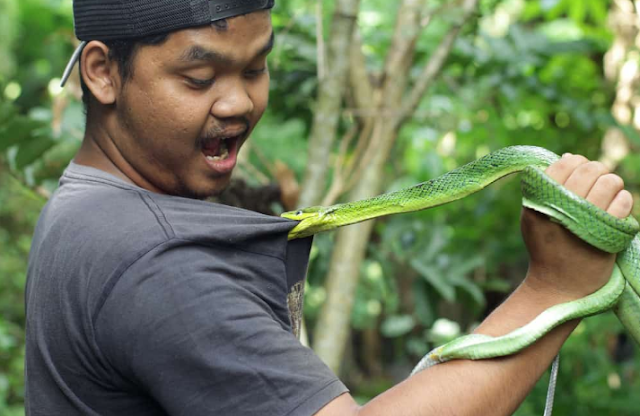Snakes typically pose no threat to people. In the US, 20% of snakes are poisonous, compared to 15% globally. The rattlesnake, coral snake, water moccasin, and copperhead are some of these that can be found in North America. They have the potential to kill you with just one mouthful. Call 911 or your local emergency number right away if you've been bitten by a poisonous snake, particularly if the bite changes color, starts to swell, or becomes painful. Antivenom medicines are widely available in emergency departments and could be beneficial.
While awaiting emergency assistance, try to follow these steps:
- Don't get too close to the serpent; move away.
- To stop the poison from spreading, remain still and composed.
- In order to avoid swelling, take off your jewelry and any restrictive apparel.
- If at all possible, position yourself so that the bite occurs at or just below the level of your diaphragm.
- Use soap and water to clean the area. Dress it in a tidy, fresh dressing.
• Caution
- Never apply cold or a tourniquet.
- Never try to cut the wound or drain the poison.
- Avoid drinking booze or caffeine because they can hasten your body's absorption of venom.
- Avoid attempting to catch the serpent. In order to explain it and aid in your treatment, try to recall its color and shape.
- Take a photo of the snake from a safe distance to aid in identification if you have a smartphone with you and it won't prevent you from getting assistance.
0
SNAKE BITE SYMPTOMS & SIGNIFICANCE
It's time to learn the vital signs and symptoms people experience after being struck by a snake now that we have more knowledge about snakes and their venom. Even though you'll almost certainly feel the bite, you or the other individual may not always be able to see what bit them. Keep an eye out for the warning signs as early detection of these symptoms may save a person's life. Depending on the type of snake, symptoms can change, but the majority are consistent and include one or more of the following.
- Two stab wounds can be seen.
- The area around the wound is red and/or swollen.
- The bite location is in pain.
- Vomiting or nauseous
- Respiration challenges
- Eye impairment
- Body or facial numbness or discomfort
- Weakness
- Immediately after being bitten by a serpent, what to do
What to do after getting bitten by a serpent is a topic of much misunderstanding. Take these actions to reduce danger and stabilize the victim of the bite in order to put that to rest.
• Obtain emergency services or an ambulance by calling
In any situation, dialing 911 should be your first move. You should always exercise caution, even if you believe the serpent wasn't poisonous. If you have a snake injury, let the emergency services know so that they can send the appropriate assistance.
Things to do
Instead of rushing for a phone when you need to remain as still as possible, use a mobile phone or ask someone else to make the call for you. Use the Emergency+ app to summon an ambulance, or dial Triple Zero (000) and request one. This app utilizes the GPS capabilities of mobile devices to provide precise location information to emergency services.
• Recall and write down specifics
Never get close to or pursue a serpent. If you can recall any information, write it down or capture it on any portable device you may have. This can aid medical workers in providing better care to their patient(s). If you administer any first aid, emergency services might ask you precisely what you did, so attempt to document your interventions as well.
• Stay composed and silent.
The lymphatic system in a person's body, which circulates throughout the complete body whenever they move, is usually where venom is carried. In fact, moving around can make the venom circulate more quickly and increase the risk. As you help the victim lie down flat and attempt to maintain their composure, make sure you are not in any danger from the snake.

Things to do
Stay put rather than moving to get assistance if you are certain the snake has left after biting you and there is no chance you will get struck again. If you are with others, they should start providing first aid where you are instead of moving you at all.
Breathe deeply and slowly to help yourself relax. Keep in mind that the odds are in your favor because most snake bite victims survive, particularly if they receive first aid.
• Cover the bite by applying pressure
The arms, hands, feet, or legs are where snake bites most frequently appear. To prevent the dissemination of the venom, apply a pressure immobilization bandage. Additionally, it safeguards the venom, allowing researchers to test it in a hospital to develop the finest possible antivenin. Just wrap the limb firmly in gauze and wrap the bandage over the bite. The extremity should be kept as still as possible while marking the bite's location on the bandage with whatever is at hand.






Post a Comment